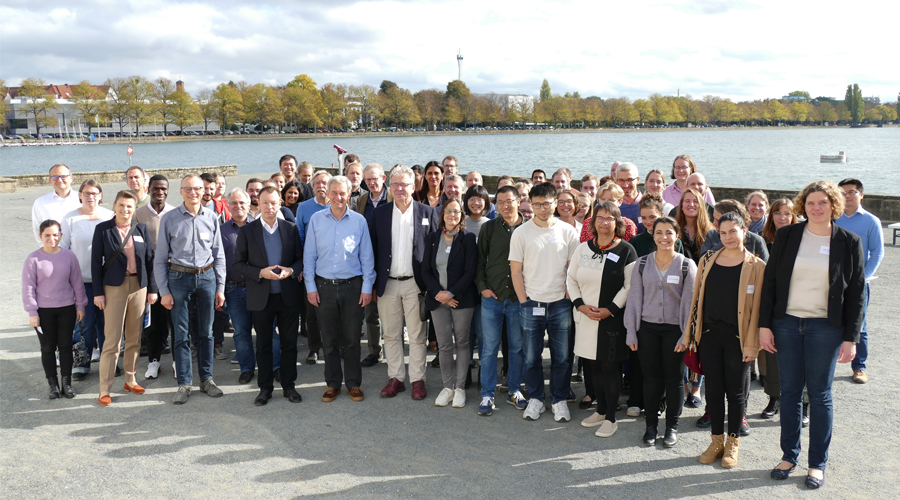The SFB 900 formed the basis for RESIST:
On 13 and 14 October 2022, the final symposium of the Collaborative Research Centre 900 “Chronic Infections: Microbial Persistence and its Control” took place.
The SFB 900 had started on 1 July 2010 and will come to an end on 31 December 2022 after 12½ years of funding by the German Research Foundation – it has thus reached the maximum possible funding period after two successful interim evaluations in 2014 and 2018 and a 6-month pandemic-related extension. SFB 900 is the first Collaborative Research Centre at the MHH to focus entirely on infections: infection topics had previously been dealt with in Collaborative Research Centres at the MHH with other foci. With its focus on chronic infections, the SFB 900 took into account the strengths of infection research at the MHH in the fields of hepatitis and herpes viruses and chronic bacterial pathogens, which had grown in the first decade of the 21st century. Together with the International Research Training Group IRTG 1273 “Strategies of human pathogens to establish acute and chronic infections”, the SFB 900 formed the basis for the Cluster of Excellence RESIST, which was launched in 2019.
The SFB 900 Symposium in October 2022 was therefore dedicated to a review and overview of the development of the currently running 19 projects over the last decade. The presentations by the SFB 900 project leaders were accompanied by talks by invited external speakers on the same research topics. On the pathogens Helicobacter pylori and Pseudomonas aeruginosa, which had been worked on as focal points in SFB 900, there were talks by S. Suerbaum, C. Josenhans, S. Bartfeld (Berlin) and B. Tümmler. They shed light on the evolution of bacterial genomes, the molecular mechanisms of the plasticity of bacterial genomes, the role of a lipopolysaccharide metabolite in the inflammatory response triggered by H. pylori and new organoid models to study the tropism of H. pylori for certain cell types of the gastrointestinal mucosa. These presentations were complemented by an overview by X. Didelot, University of Warwick, UK, on new phylogenetic methods for reconstructing the evolution of bacterial genomes and by a lecture by G. Graßl, MHH, on chronic Salmonella infections.
The major topic “Immune responses in chronic infections” was introduced by an engaging talk by A. Hayday, King’s College London; he spoke about immune mechanisms that restore homeostasis after infection and cancer. This was followed by talks by I. Prinz, S. Ravens, B. Eiz-Vesper on and T cells in viral infections and by A. M. Leen, Texas, on antiviral T cell therapies. H. Wedemeyer and M. Cornberg shed light on the ongoing changes in the immune system after hepatitis C virus infections, and R. Förster, L. Cicin-Sain, U. Kalinke and M. Brinkmann reported on their many years of work on the confrontation of the innate and adaptive immune system with cytomegalovirus. A lecture by S. Urban, Heidelberg, summarised his many years of work, which had led to the development of an inhibitor of the hepatitis B and D virus now approved in the clinic. A subsequent visit to the Wilhelm Busch Museum and viewing the drawings by Wilhelm Busch and the English caricatures of the 18th century exhibited there provided an occasion for interesting discussions – especially for doctoral students from other cultural backgrounds – about the development of freedom of the press and freedom of opinion in the 18th and 19th centuries.
The second day of the symposium was dedicated to chronic viral infections, in particular the three herpes viruses worked on in SFB 900 Herpes simplex virus (HSV; B. Sodeik, A. Viejo-Borbolla, A. Cliffe), human cytomegalovirus (HCMV; M. Messerle, N. Stern-Ginossar), Kaposi’s sarcoma-associated herpes virus (KSHV/HHV8; T. Schulz), as well as two hepatitis viruses, hepatitis C virus (HCV; T. Pietschmann, G. Gerold, J. Marcotrigiano) and hepatitis E virus (HEV; T. Krey). C. Goffinet reported on her recent work on SARS-CoV-2. Finally, two invited speakers gave talks on new ways of defending the cell against intracellular pathogens: P. Lehner (University of Cambridge) on his work on the HUSH complex and epigenetic mechanisms in defence against retroviral genomes, and M. Gack (Lerner Research Institute, Cleveland Clinic, Florida) on the role of cellular non-coding RNAs in stimulating the innate immune response.
All in all, we all felt that this symposium, which reflected a twelve-year research programme and had also offered many new suggestions and insights, had been a worthy scientific conclusion to our SFB 900.
Thomas Schulz

